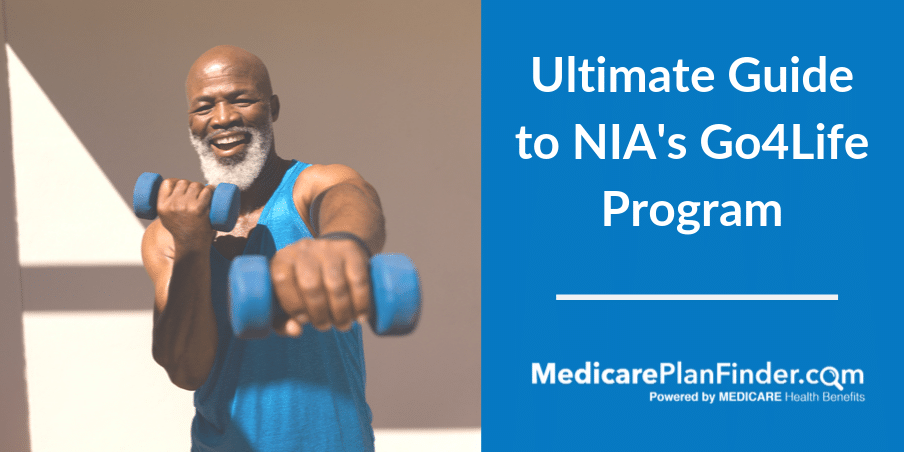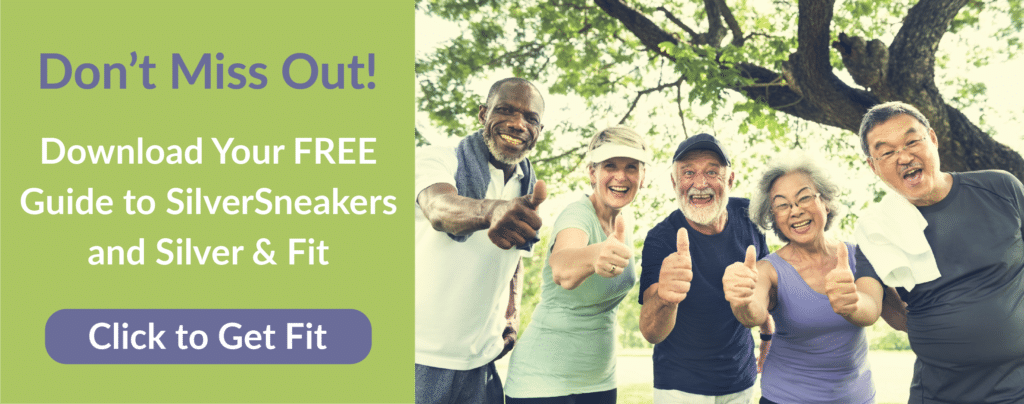
Ultimate Guide to NIA’s Go4Life® Program
October 14, 2019According to the US Department of Health and Human Services (HHS), “only 28-34 percent of adults ages 65-74 are physically active.” In an effort to get seniors moving, the National Institute of Aging (NIA) launched the Go4Life® campaign.
What Is Go4Life®?
Go4Life® is exercise and physical activity campaign from the National Institute of Aging at NIH (National Institutes of Health) that’s designed to help people include exercise and physical activity in their daily lives.
According to NIA, the campaign’s “essential elements are motivating older adults to become physically active for the first time, return to exercise after a break in their routines, or build more exercise and physical activity into weekly routines.”
The campaign offers exercise guides, motivational tips, and other free resources such as tracking tools to help you get started with and keep at physical activity.
Go4Life ® Types of Exercise
Go4Life®’s goal is to have people focus on more than one type of exercise. The campaign recommends doing four types of exercise for comprehensive physical fitness*:
- Endurance
- Strength
- Balance
- Flexibility
*Always check with your doctor before starting any exercise program.
Endurance
Endurance activities are also called aerobic or cardiovascular exercise.
Benefits of Endurance Training
According to the Mayo Clinic, cardiovascular exercise has many benefits including:
- Strengthening your heart and muscles
- Burning calories
- Helping control your appetite
- Boosting your mood through endorphins (feel-good chemicals)
- Helping you sleep better at night
- Reducing arthritis pain and joint stiffness
- Helping prevent or manage high blood pressure, heart disease and diabetes
Endurance Training Exercises
Go4Life® recommends the following endurance exercises:
- Mall Walking: Malls provide a safe space for walking that’s free from bad weather and traffic.
- Walking or Rolling Exercise: Brisk walking or rolling in a wheelchair around your neighborhood or other outdoor areas can increase your heart rate and breathing.
- Exercise Around the House: You don’t even need to leave your home to be active! For example, gardening, sweeping, raking, and shoveling snow are great ways to get your heart rate up.
- Outdoor Activities: These activities include cycling, horseback riding, sailing, jogging, skating, snorkeling, and swimming.
- Indoor Activities: These activities include indoor lap swimming, using cardio equipment at your local gym, dancing, water aerobics, martial arts, and/or bowling.
- Sports: Competition and teamwork can be extremely motivating. Sports such as tennis, pickleball, volleyball, and hockey can be great ways to raise your heart rate and help keep you healthy.
Strength
When many people think of strength training, they think of lifting weights at the gym. While that is one way, you can also get valuable strength training in the comfort of your own home with dumbbells and/or resistance bands.
Benefits of Weight Lifting
According to RunRepeat.com, “long-term lifting is the best way to prevent age-related muscle loss,” and lifting is “even prescribed for the prevention of diseases like osteoporosis.” Other benefits include:
- Burning fat
- Increasing muscle mass
- Supporting functional independence
- Improving balance
- Greater cardiovascular health
- Improving mental health
- Fighting type 2 diabetes
Weight Lifting Routines for Seniors and Medicare Eligibles
Go4Life® suggests gradually increasing the weight you use to build strength. Start with a weight you can lift eight times maximum. Use the same weight until you can easily do 10-15 repetitions.
When you can do two sets of 10-15 repetitions, add more weight. You should only be able to lift the new weight eight times. Then repeat that cycle until you reach your goal. Go4Life® recommends the following strength exercises. You can find exercise instructions here.
Upper Body Exercises
- Seated rows with resistance bands
- Chair dips
- Bicep curls with resistance bands
- Wall pushups
- Dumbbell bicep curls
- Lateral raises with dumbbells
- Front raises with dumbbells
- Overhead presses with dumbbells
- Dumbbell wrist curls
- Grip exercise with a tennis ball
- Tricep extensions with a dumbbell
Lower Body Exercises
- Calf raises using a chair for balance
- Standing from a chair
- Leg extensions
- Leg curls
- Lateral leg raises
- Back leg raises
Balance
As we age, our sense of balance can change. According to Harvard University, we lose our sense of balance if we aren’t physically active.
Benefits of Balance Training
According to the National Council on Aging (NCOA), about 25 percent of adults over 65 fall every year, and the right exercise program can help seniors prevent falls. It makes sense, too. NIA says that having good balance will help you carry out daily activities such as walking up and down stairs and navigating around objects on the floor.
Balance Exercises to Try at Home
Follow the instructions here to start Go4life®’s balance training routine.
- Tai Chi
- Walking exercises that emphasize balance
- Standing on one foot
Flexibility
Flexibility training involves stretching muscle groups to improve your range of motion.
Benefits of Flexibility Training
According to the National Strength and Conditioning Association (NSCA), improving your flexibility helps prevent injuries such as strains, sprains, and tears.
Flexibility Training Ideas
Go4Life recommends doing the following stretches three to five times whenever you exercise. You can do all of these exercises at home using a chair, supporting yourself with a wall, or lying on the floor.
- Partner stretch
- Standing calf stretch
- Lying lower back stretch
- Lying hip stretch
- Standing thigh stretch
- Lying thigh stretch
- Seated back of leg stretch
- Lying back of leg stretch
- Seated ankle stretch
- Various seated back stretches
- Getting up from a lying position on the floor
- Lying down from a seated position
Go4Life® also recommends yoga to help improve your flexibility.
Medicare Fitness Coverage
If you’re eligible for Medicare, you may be able to find coverage for gym memberships and fitness classes. Original Medicare, the public health insurance does not offer a fitness benefit. However, certain private insurance policies called Medicare Advantage plans can cover gym memberships and fitness classes.
Programs such as Silver & Fit® and SilverSneakers® partner with insurance carriers and local gyms to offer beneficiaries discounted memberships. Some insurance carriers even offer their own fitness benefits.
Some Medicare Advantage plans that offer fitness benefits even have $0 monthly premiums*! Plan benefits and availability vary by location, so check with your agent if you have questions about Medicare fitness coverage.
*Even if your Medicare Advantage plan has a $0 premium, you may still owe the Part B premium.

Find Coverage for Medicare Fitness Programs
Go4Life® provides exercise guidance so seniors can get active. If you want to learn about Medicare Advantage fitness coverage, a licensed agent with Medicare Plan Finder can help. Our agents are highly trained and they may be able to help you find a plan that fits your lifestyle and budget. To set up a no-cost, no-obligation appointment, call 844-431-1832 or contact us here today.


